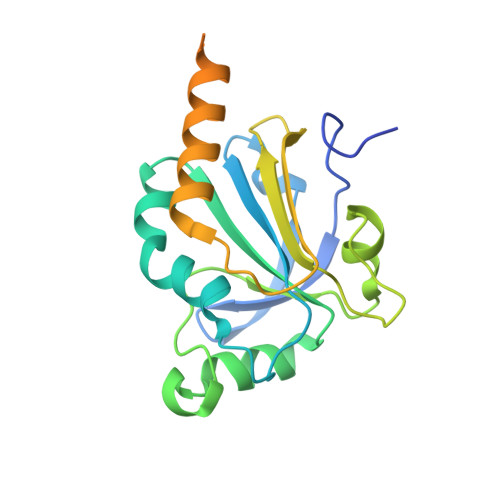Calcium sensing via EF-hand 4 enables thioredoxin activity in the sensor-responder protein calredoxin in the green algaChlamydomonas reinhardtii.
Charoenwattanasatien, R., Zinzius, K., Scholz, M., Wicke, S., Tanaka, H., Brandenburg, J.S., Marchetti, G.M., Ikegami, T., Matsumoto, T., Oda, T., Sato, M., Hippler, M., Kurisu, G.(2020) J Biol Chem 295: 170-180
- PubMed: 31776187
- DOI: https://doi.org/10.1074/jbc.RA119.008735
- Primary Citation of Related Structures:
6J13 - PubMed Abstract:
Calcium (Ca 2+ ) and redox signaling enable cells to quickly adapt to changing environments. The signaling protein calredoxin (CRX) from the green alga Chlamydomonas reinhardtii is a chloroplast-resident thioredoxin having Ca 2+ -dependent activity and harboring a unique combination of an EF-hand domain connected to a typical thioredoxin-fold. Using small-angle X-ray scattering (SAXS), FRET, and NMR techniques, we found that Ca 2+ -binding not only induces a conformational change in the EF-hand domain, but also in the thioredoxin domain, translating into the onset of thioredoxin redox activity. Functional analyses of CRX with genetically altered EF-hands revealed that EF-hand 4 is important for mediating the communication between the two domains. Moreover, we crystallized a variant (C174S) of the CRX target protein peroxiredoxin 1 (PRX1) at 2.4 Å resolution, modeled the interaction complex of the two proteins, and analyzed it by cross-linking and MS analyses, revealing that the interaction interface is located close to the active sites of both proteins. Our findings shed light on the Ca 2+ binding-induced changes in CRX structure in solution at the level of the overall protein and individual domains and residues.
Organizational Affiliation:
Institute for Protein Research, Osaka University, 3-2 Yamadaoka, Suita Osaka 565-0871, Japan; Synchrotron Light Research Institute (Public Organization), 30000 Nakhon Ratchasima, Thailand.














